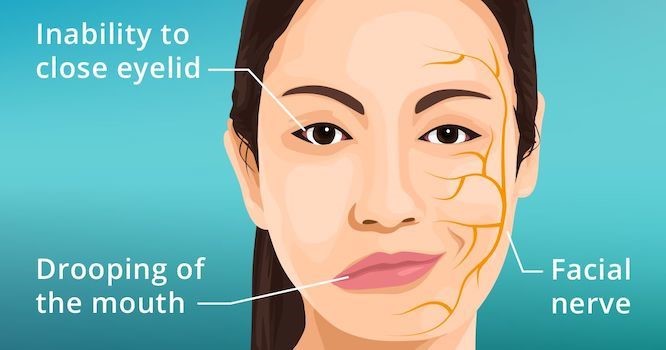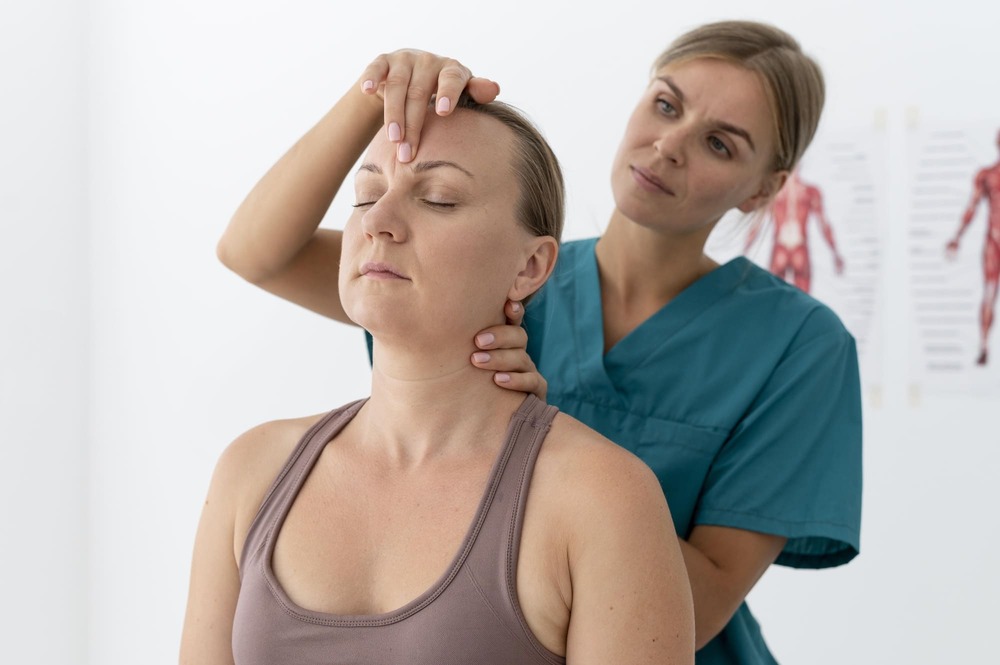Last updated on May 10th, 2025 at 05:55 pm

Bells Palsy treatment aims to alleviate the symptoms, promote recovery, and prevent complications associated with this condition, which causes sudden paralysis or weakness in the facial muscles, typically on one side of the face.
Bell’s Palsy is a sudden, unexplained weakness or paralysis of the facial muscles, typically on one side of the face. It can cause facial drooping, difficulty closing one eye, and impaired ability to smile or make facial expressions. Although it can be alarming, Bell’s Palsy is usually temporary and, in most cases, resolves on its own over weeks to months.
Bells Palsy Treatment
The treatment for Bells Palsy is as follows:
1. Corticosteroids
Corticosteroids like prednisone are often prescribed to reduce inflammation and swelling of the facial nerve. These medications can help speed up the recovery process and improve outcomes. Early administration is crucial, so seeking medical attention promptly is essential.
2. Antiviral Medications
In some cases, antiviral medications such as acyclovir may be prescribed if there is suspicion of a viral infection contributing to Bell’s Palsy. However, the efficacy of antivirals in Bell’s Palsy treatment remains a topic of debate among medical professionals.
3. Eye Care
Proper eye care is crucial, as the inability to close one eye fully can lead to dryness and potential damage. Lubricating eye drops, eye patches, or protective glasses may be recommended to prevent complications.

Bell’s Palsy Physiotherapy Treatment – Complementary Therapies
1. Physical Therapy
Physical therapy can play a significant role in Bell’s Palsy recovery. Exercise and massage techniques can help maintain muscle tone and improve facial mobility.
2. Acupuncture
Some individuals with Bell’s Palsy have reported positive outcomes with acupuncture. This traditional Chinese therapy involves inserting thin needles into specific points on the body to stimulate healing and improve nerve function.
3. Electrical Stimulation
In certain cases, electrical stimulation devices may be prescribed by a healthcare provider. These devices send electrical impulses to the affected facial muscles, which can help improve muscle strength and control.
4. Relaxation Techniques
Stress and anxiety can exacerbate symptoms of Bell’s Palsy. Relaxation techniques such as meditation and deep breathing exercises can help reduce stress and support the body’s natural healing processes.
Consult a Doctor and Medkart will help you Order Medicines Online
Home Remedies for Bell’s Palsy Treatment
Home remedies can complement medical treatments for Bell’s Palsy by promoting relaxation, reducing inflammation, and supporting overall well-being during recovery. Here are some effective home remedies:
1. Facial Massage
Gently massaging the affected side of the face can help improve blood circulation and muscle tone. Use a mild, natural oil like coconut or olive oil to avoid skin irritation.
2. Heat Therapy
Applying a warm compress to the paralyzed side of the face for about 15-20 minutes several times a day can help alleviate pain and relax facial muscles.
3. Eye Care
To prevent eye dryness and irritation, use lubricating eye drops and cover the affected eye with a patch or protective eyewear, especially during sleep.
4. Diet and Nutrition
Consume a balanced diet rich in vitamins and minerals, particularly those that support nerve health, such as B vitamins and antioxidants. Stay hydrated to aid in overall recovery.
5. Stress Reduction
High stress levels can exacerbate Bell’s Palsy symptoms. Practice relaxation techniques like meditation, deep breathing exercises, and yoga to manage stress effectively.
6. Herbal Supplements
Some individuals find relief from Bell’s Palsy symptoms by taking herbal supplements like ginseng or turmeric. However, consult with a healthcare specialist before beginning any new supplements.
7. Facial Exercises
Gentle facial exercises, like smiling, frowning, and puffing out your cheeks, can help maintain muscle tone and promote facial symmetry.
Remember that while these home remedies can be beneficial, they should complement medical treatment, not replace it. Always consult with a healthcare provider to ensure you’re following the most appropriate and effective treatment plan for your specific condition.
Bells Palsy Physiotherapy
Bell’s Palsy physiotherapy treatment involves targeted exercises and techniques to improve facial muscle strength and mobility. Physiotherapists design customized regimens to help patients regain control over their facial expressions and functions.
These exercises may include facial massages, muscle stretches, and electrical stimulation to stimulate nerve recovery. By working closely with a physiotherapist, individuals with Bell’s Palsy can enhance their chances of a quicker and more complete recovery, ultimately restoring their facial symmetry and function.
Conclusion
While a Bell’s Palsy diagnosis can be unsettling, the good news is that most individuals with this condition experience a full recovery over time. Seeking prompt medical attention and following a treatment plan, which may include corticosteroids, antiviral medications, and physical therapy, can significantly improve outcomes. Complementary therapies and emotional support also play essential roles in the healing process.
Remember that each person’s journey with Bell’s Palsy is unique. Maintaining a positive outlook, staying informed, and seeking support can help you navigate this temporary challenge and look forward to regaining full facial function. With the right treatment and care, there is hope for a bright and smile-filled future.
Why do Generic and Brand-name drugs look different?
Generic and brand-name drugs can look different primarily due to trademark laws and regulations. While the active ingredients in both versions are the same, manufacturers of generic drugs are not allowed to copy the exact appearance of the brand-name medication.
This distinction helps consumers and healthcare professionals differentiate between the two and prevents confusion. However, the quality, safety, and effectiveness of generic drugs are rigorously tested and regulated to ensure they are equivalent to their brand-name counterparts.
Read: What are Generic Medicines?
FAQs on Bells Palsy Treatment
Q1. What is Bells Palsy treatment?
Bell’s Palsy treatment typically involves corticosteroids to reduce inflammation, antiviral medications if infection is suspected, and supportive measures like eye care. Physical therapy and complementary therapies may be used to enhance facial muscle recovery.
Q2. What is the best bell’s palsy treatment?
The best Bell’s Palsy treatment typically involves early administration of corticosteroids and, if appropriate, antiviral medications, along with eye care. Consulting a healthcare professional for a tailored treatment plan is essential for the best outcomes.
Q3. Can Bell’s Palsy be treated at home without medical intervention?
While home remedies like facial exercises and warm compresses can help, it’s crucial to consult a healthcare provider for proper diagnosis and treatment, which often includes corticosteroids and eye care.
Q4. Is surgery required for Bells Palsy treatment?
Surgery is rarely necessary for Bell’s Palsy. Medical treatments, physical therapy, and complementary therapies are usually sufficient to promote recovery. Surgery may be considered in exceptional cases with severe complications.
Related Links: